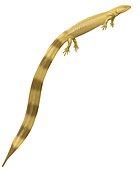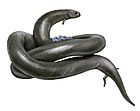Diploceraspis
| Diploceraspis Temporal range: Early Permian
| |
|---|---|

| |
| Scientific classification | |
| Kingdom: | Animalia |
| Phylum: | Chordata |
| Subclass: | †Lepospondyli |
| Order: | †Nectridea |
| Family: | †Diplocaulidae |
| Genus: | †Diploceraspis Romer, 1952 |
| Type species | |
| Diploceraspis burkei Romer, 1952
| |
Diploceraspis is an extinct genus of lepospondyl amphibian. It lived in North America during the Permian period. It closely resembles its relative, Diplocaulus. It generally sports the same features as Diplocaulus, though it was smaller, measuring over 46 cm.[1] Beerbower originally recognised two species, D.burkei and D.conemaughensis, but they are no longer regarded as being distinct from one another as their size ranges were found to overlap.[2] Other species include D. meritae from Nebraska and an indeterminate species from Oklahoma.[3] Diplocaulus minimus of Late Permian Morocco may be of this genus.[2]
References[]
- ^ http://www.angellis.net/Web/PDfiles/amphs.pdf[bare URL PDF]
- ^ a b Germain D. (2010). "The Moroccan diplocaulid: the last lepospondyl, the single one on Gondwana". Historical Biology. 22 (1–3): 4–39. doi:10.1080/08912961003779678.
- ^ May, William J.; Hall, Joseph D. (2016). "First Occurrence of the Diplocaulid Genus Diploceraspis from the Wellington Formation (Lower Permian) of Northern Oklahoma". Transactions of the Kansas Academy of Science. 119 (2): 193–199. doi:10.1660/062.119.0209.
Categories:
- Diplocaulids
- Cisuralian amphibians of North America
- Fossil taxa described in 1963
- Prehistoric amphibian stubs



